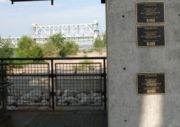
Great Flood of 1844
Encyclopedia
The Great Flood of 1844 is the biggest flood
ever recorded on the Missouri River
and Upper Mississippi River
, in North America
, in terms of discharge.
The impact was not as great as subsequent floods because of the small population in the region at the time. The flood devastation was particularly widespread since the region had little or no levees at the time, so the waters were able to spread far from the normal banks.
Among the hardest hit were the Wyandot Indians who lost 100 people in the diseases that occurred after the flood in the vicinity of today's Kansas City, Kansas
the Wyandot were a people formed from the war and disease depopulated elements of the once mighty Huron Confederacy and the Petun
Indian tribes who had migrated south and west.
The flood also placed a major obstacle, a sandbar in front of the Wayne City Landing at Independence, Missouri
which was to cause and encourage settlers to go further east to Westport Landing in Kansas City
causing significant local economic and cultural impact. Independence had been the jumping off place for several key emigrant trail
s, prior to 1846 notably both the Santa Fe Trail
and one alternative eastern starting branch of the Oregon Trail
. After the Mexican-American war settlement of 1846, the Oregon's start quickly also became a start of the California Trail
and an alternative beginning also for the Mormon Trail
(Church of Jesus Christ of Latter Day Saints migration to Utah
).
Congress in 1849 passed the Swamp Act providing land grants to build stronger levees.
The flood also is the highest recorded for the Mississippi River
at St. Louis (1,300,000 cubic feet second in 1844 vs. 782,000 in 1951 and 1,030,000 in 1993).
 Channeling and levee construction have altered how the floods have hit various areas along the Missouri River. Here's a comparison of the four big floods since the early 19th century.
Channeling and levee construction have altered how the floods have hit various areas along the Missouri River. Here's a comparison of the four big floods since the early 19th century.
Flood
A flood is an overflow of an expanse of water that submerges land. The EU Floods directive defines a flood as a temporary covering by water of land not normally covered by water...
ever recorded on the Missouri River
Missouri River
The Missouri River flows through the central United States, and is a tributary of the Mississippi River. It is the longest river in North America and drains the third largest area, though only the thirteenth largest by discharge. The Missouri's watershed encompasses most of the American Great...
and Upper Mississippi River
Upper Mississippi River
The Upper Mississippi River is the portion of the Mississippi River upstream of Cairo, Illinois, United States. From the headwaters at Lake Itasca, Minnesota, the river flows approximately 2000 kilometers to Cairo, where it is joined by the Ohio River to form the Lower Mississippi...
, in North America
North America
North America is a continent wholly within the Northern Hemisphere and almost wholly within the Western Hemisphere. It is also considered a northern subcontinent of the Americas...
, in terms of discharge.
The impact was not as great as subsequent floods because of the small population in the region at the time. The flood devastation was particularly widespread since the region had little or no levees at the time, so the waters were able to spread far from the normal banks.
Among the hardest hit were the Wyandot Indians who lost 100 people in the diseases that occurred after the flood in the vicinity of today's Kansas City, Kansas
Kansas City, Kansas
Kansas City is the third-largest city in the state of Kansas and is the county seat of Wyandotte County. It is a suburb of Kansas City, Missouri, and is the third largest city in the Kansas City Metropolitan Area. The city is part of a consolidated city-county government known as the "Unified...
the Wyandot were a people formed from the war and disease depopulated elements of the once mighty Huron Confederacy and the Petun
Petun
The Petún , or Tionontati in their language, were an Iroquoian-speaking First Nations people closely related to the Wendat Confederacy. Their homeland was located along the southwest edge of Georgian Bay, in the area immediately to the west of the Huron territory in Southern Ontario of...
Indian tribes who had migrated south and west.
The flood also placed a major obstacle, a sandbar in front of the Wayne City Landing at Independence, Missouri
Independence, Missouri
Independence is the fourth largest city in the U.S. state of Missouri, and is contained within the counties of Jackson and Clay. It is part of the Kansas City Metropolitan Area...
which was to cause and encourage settlers to go further east to Westport Landing in Kansas City
Kansas City, Missouri
Kansas City, Missouri is the largest city in the U.S. state of Missouri and is the anchor city of the Kansas City Metropolitan Area, the second largest metropolitan area in Missouri. It encompasses in parts of Jackson, Clay, Cass, and Platte counties...
causing significant local economic and cultural impact. Independence had been the jumping off place for several key emigrant trail
Emigrant Trail
The Emigrant Trails were the northern networks of overland wagon trails throughout the American West, used by emigrants from the eastern United States to settle lands west of the Interior Plains during the overland migrations of the mid-19th century...
s, prior to 1846 notably both the Santa Fe Trail
Santa Fe Trail
The Santa Fe Trail was a 19th-century transportation route through central North America that connected Missouri with Santa Fe, New Mexico. Pioneered in 1822 by William Becknell, it served as a vital commercial and military highway until the introduction of the railroad to Santa Fe in 1880...
and one alternative eastern starting branch of the Oregon Trail
Oregon Trail
The Oregon Trail is a historic east-west wagon route that connected the Missouri River to valleys in Oregon and locations in between.After 1840 steam-powered riverboats and steamboats traversing up and down the Ohio, Mississippi and Missouri rivers sped settlement and development in the flat...
. After the Mexican-American war settlement of 1846, the Oregon's start quickly also became a start of the California Trail
California Trail
The California Trail was an emigrant trail of about across the western half of the North American continent from Missouri River towns to what is now the state of California...
and an alternative beginning also for the Mormon Trail
Mormon Trail
The Mormon Trail or Mormon Pioneer Trail is the 1,300 mile route that members of The Church of Jesus Christ of Latter-day Saints traveled from 1846 to 1868...
(Church of Jesus Christ of Latter Day Saints migration to Utah
Utah
Utah is a state in the Western United States. It was the 45th state to join the Union, on January 4, 1896. Approximately 80% of Utah's 2,763,885 people live along the Wasatch Front, centering on Salt Lake City. This leaves vast expanses of the state nearly uninhabited, making the population the...
).
Congress in 1849 passed the Swamp Act providing land grants to build stronger levees.
The flood also is the highest recorded for the Mississippi River
Mississippi River
The Mississippi River is the largest river system in North America. Flowing entirely in the United States, this river rises in western Minnesota and meanders slowly southwards for to the Mississippi River Delta at the Gulf of Mexico. With its many tributaries, the Mississippi's watershed drains...
at St. Louis (1,300,000 cubic feet second in 1844 vs. 782,000 in 1951 and 1,030,000 in 1993).
Comparison to other big floods

- Great Flood of 1844 — This was the biggest flood of the three in terms of cubic feet/second discharge at Westport Landing in Kansas City. It is estimated that 625,000 cubic feet/second was discharged in the flood. However the crest on July 16, 1844, almost a foot lower than the 1993 flood.
- Flood of 1851Flood of 1851The Great Flood of 1851 occurred after record-setting rainfalls across the U.S. Midwest and Plains from May to August, 1851. Hardest hit was the State of Iowa, with significant flooding extending to the Lower Mississippi River basin. Historical evidence suggest flooding occurred in the eastern...
— While the Great Flood of 1851 was most severe in Iowa, it also affected the Missouri and Mississippi river basins. In St. Louis, MissouriSt. Louis, MissouriSt. Louis is an independent city on the eastern border of Missouri, United States. With a population of 319,294, it was the 58th-largest U.S. city at the 2010 U.S. Census. The Greater St...
, on June 11, 1851 flood waters rose to within 5 feet (1.5 m) of the 1844 flood, while at Cape Girardeau, MissouriCape Girardeau, MissouriCape Girardeau is a city located in Cape Girardeau and Scott counties in Southeast Missouri in the United States. It is located approximately southeast of St. Louis and north of Memphis. As of the 2010 census, the city's population was 37,941. A college town, it is the home of Southeast Missouri...
the flooding was worse than in 1844.
- Great Flood of 1951Great Flood of 1951In mid-July 1951, heavy rains led to a great rise of water in the Kansas River and other surrounding areas. Flooding resulted in the Kansas, Neosho, Marais Des Cygnes, and Verdigris river basins. The damage in June and July 1951 exceeded $935 million dollars in an area covering eastern Kansas and...
— The 1951 flood was the second biggest in terms of cubic feet/second discharge at 573,000 cubic feet/second. The 1951 crest on July 14, 1951, was almost two feet lower than the 1844 flood and three feet lower than 1993. However, the flood was the most devastating of all modern floods for Kansas City since its levee system was not built to withstand it. It destroyed the city's stockyards and forced the building of an airport away from the Missouri River bottoms.
- Great Flood of 1993Great Flood of 1993The Great Mississippi and Missouri Rivers Flood of 1993 occurred in the American Midwest, along the Mississippi and Missouri rivers and their tributaries, from April to October 1993. The flood was among the most costly and devastating to ever occur in the United States, with $15 billion in damages...
— The 1993 flood was the highest of any of the three but had the lowest discharge (541,000 c.f.s.). While the 1993 flood had devastating impacts elsewhere, Kansas City survived it relatively well because of levees improvements after the 1951 flood.

